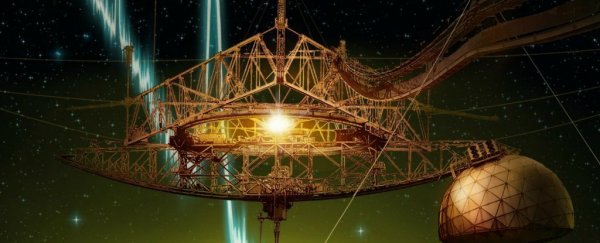For the past decade, astronomers have been picking up incredibly powerful explosions of radio signals coming from outer space, called fast radio bursts (FRBs).
They only last a few milliseconds, but they can generate as much energy as 500 million suns - and we've never been able to explain where they're coming from, or what causes them.
Now, for the first time, scientists have traced the origin of one of these bursts to a tiny dwarf galaxy far beyond our Milky Way, and it provides a strong lead as to the source of these mysterious signals.
"We now know that this particular burst comes from a dwarf galaxy more than three billion light-years from Earth," said one of the researchers involved in the discovery, Shami Chatterjee, from Cornell University.
"That simple fact is a huge advance in our understanding of these events."
The findings have been presented today at a meeting of the American Astronomical Society in Texas, and simultaneously published in papers in Nature and the Astrophysical Journal Letters. And they're a pretty huge deal for astronomers.
The first fast radio burst was discovered in 2007, and since then, astronomers have been manically searching to spot more of the mysterious signals.
Despite the fact that researchers estimate there are around 2,000 of these FRBs firing across the Universe every single day, they're so short lived that catching them is easier said than done.
The few signals we did manage to detect were erratic and all came from different places, making it incredibly hard to nail down what the hell was causing them.
But that all changed last year, when researchers detected the first evidence of a repeating FRB - 11 radio bursts all coming from a single region, far beyond the Milky Way. Then, just last month, six more FRBs were detected coming from the same location. These repeating signals were given the name FRB 121102.
Now, using the Very Large Array (VLA) telescope in New Mexico, researchers have finally been able to pinpoint their precise origin.
In 83 hours of observing time over six months in 2016, the VLA detected nine bursts from FRB 121102.
And that was enough to allow them to hone in on their source. To their surprise, the FRBs were coming from a faint dwarf galaxy, more than 3 billion light-years from Earth.
"We are the first to show that this is a cosmological phenomenon. It's not something in our backyard. And we are the first to see where this thing is happening, in this little galaxy, which I think is a surprise," said one of the researchers, Casey Law, from the University of California at Berkeley.
"Now our objective is to figure out why that happens."
Before the discovery of these repeating FRBs, the leading hypothesis was that the bursts were coming from within our Milky Way, and were the result of a one-off cataclysmic collision between two neutron stars, a process that forms a black hole. But that's now been ruled out.
"Before we knew the distance to any FRBs, several proposed explanations for their origins said they could be coming from within or near our own Milky Way Galaxy," said one of the team, Shriharsh Tendulkar, from McGill University in Canada.
"We now have ruled out those explanations, at least for this FRB."
Another clue in the new discovery is that, in addition to detecting the incredibly powerful FRBs, the team observed an ongoing, persistent source of weaker radio emission in the same region, which was coming from within 100 light-years of the fast radio bursts.
"We think that the bursts and the continuous source are likely to be either the same object or that they are somehow physically associated with each other," said team member Benito Marcote, of the Joint Institute for VLBI ERIC in the Netherlands.
The top candidates now for the source of these repeating FRBs are young neutron stars - dense objects that form after a star collapses, and emit regular radio pulses as they spin.
A leading hypothesis among the team is that the radio bursts could even be produced by highly-magnetic magnetars - a type of neutron star that's surrounded by material ejected by a supernova explosion or rejected by a resulting pulsar.
But there are other possibilities too, such as the idea that the galaxy is blasting out radio emissions from the region surrounding the supermassive black hole at its core.
There's also the possibility that these repeating FRBs coming from this distant dwarf galaxy are different somehow to the one-off events we've detected before, and may have a totally different source.
Either way, we now at least have a place to start when it comes to our understanding of these enigmatic signals.
"Finding the host galaxy of this FRB, and its distance, is a big step forward, but we still have much more to do before we fully understand what these things are," said Chatterjee.
"There used to be an expression, 'as unchanging as the heavens,'" he told National Geographic. "But the heavens are changing very fast. The sky is just boiling and seething with these incredibly powerful events that we don't really understand."
The research has been published in Nature and the Astrophysical Journal Letters.
